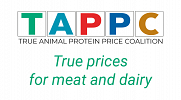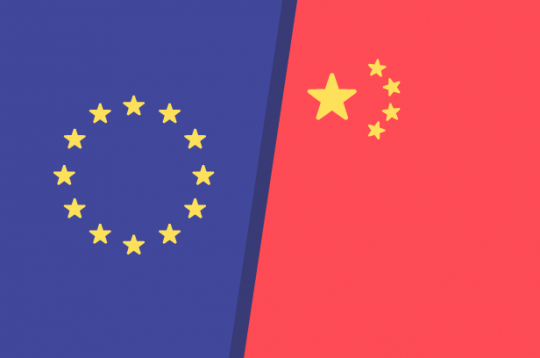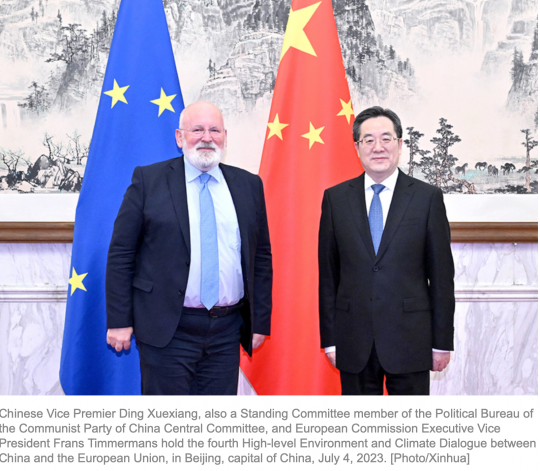TAPP Coalition proposal for EU-China dialogue on Carbon Pricing Agri-Food
Today, TAPP Coalition director Jeroom Remmers invited Frans Timmermans and the First Vice Premier of the People’s Republic of China Ding Xuexiang, to consider to start an ETS system for GHG-emissions from the meat and dairy industry or include meat/dairy food processor companies into the existing ETS system for the GHG-emissions from meat/dairy products involved. This would be a logical next step to their existing ETS systems and agreements made 4th July between the two blocks.
The 4th EU-China High-Level Environment and Climate Dialogue was held 4th July. Here, the EU and China have "agreed to intensify cooperation on emissions trading, based on the 2018 Memorandum of Understanding between the European Commission and the Ministry of Ecology and Environment of the People’s Republic of China".
As climate leaders in the world, both the EU and China have ETS system for reducing greenhouse gasses in the energy and industry sector, China since 2020.
TAPP Coalition wrote: "We would recommend both the EU and China to consider to start an ETS system for GHG-emissions from the beef-, pork, and dairy industry or include meat/dairy food processor companies into the existing ETS system for the GHG-emissions from meat/dairy involved. These two products generate 80% of GHG-emissions from diets in the EU; in China it will be similar. The EU Commission (Directorat General Climate) recently commissioned a report on options for A ETS system for agri-food in combination with paying farmers subsidies for reducing GHG emissions. In our newsmessage you can read more about it. We and the EU young farmer organisation would prefer the policy option for slaugherhouses and dairyfactories to be charged for CO2 eq emissions from food sales. The full report is expected to be published this autumn".
TAPP Coalition wrote: "We hope China can start a similar study to find out what are the best options with maximum impact on reducing GHG-emissions while taking into account concerns of citizens, farmers and companies. We expect this policy option is really effective in realising many policy goals in one time: reducing GHG-emissions, reducing deforestation as a result of animal feed needed for meat/dairy production and reducing health care costs as a result of overconsumption of red and processed meat (above levels of WHO / EAT recommendations)".
According to Chatham House and many other well known organisations and research institutes including the last IPCC-report, the Paris Climate Agreement cannot be met without meat consumption reducing policies. Carbon pricing agri-food emissions may be the answer, which will increase prices for meat/dairy, while reducing taxes and prices of food with low carbon footprints like vegetables, fruit and plant based meat/dairy.
The TAPP Coalition invited Frans Timmermans (vice chair EU Commission) and the Chinese government representatives to start an EU-China or China-OECD dialogue on carbon pricing agri-food. Another option is to become an active member of a new proposal for a High-Level Committee for Carbon Pricing Agri-Food in the Carbon Pricing Leadership Coalition (CPLC). Denmark and New Zealand already announce carbon pricing of GHG-emissions from their livestock sector.
Finally TAPP Coalition invited Chinese and an EU COP28 representatives (agriculture/food expert) to be key note speakers for side events or press conferences it will organise during COP28, eg. at the Food Pavillion, to start a dialogue and exchange views. More background information can be found in a news item about TAPP Coalition activities on GHG-emission taxes on agri-food, during the last UN Climate Conference COP27 in Egypt.
The EU and China are responsible for most meat consumption in the world (45%). Meat accounts for 60% of GHG-emissions from food, while meat and dairy are causing 20% of global GHG emissions, equal to all GHG-emissions from the USA and Russia combined. The most populous country, China, consumes almost one-third of the world’s meat and has accounted for one- third of the growth in consumption over the last 20 years, even though its per capita consumption is still less than half that of the USA. Demand in China is likely to continue to rise, though at a much slower rate due to rising concerns about obesity and a population that is set to shrink from 2030 onwards. The EU-28 (including UK) is consuming 34.814 mln kg of meat (based on 67,6 kg meat/capita, source: Our world in data (2018) and 515 mln inhabitants). The USA is consuming 32.702 mln kg of meat (based on 98,6 kg meat/capita consumption, Our world in data 2018). Meat consumption per capita in 2018 was 62,7 kg x 1,412 billion citizens is equal to 88.532 million kg of meat consumption. More background information can be found in the Meat Atlas 2021. A tax on meat at EU level could reduce 120 mton CO2 eq emissions per year (3% of all GHG emissions in the EU-28), a study commissioned by TAPP Coalition found. A more recent study also calculated effects for taxing meat, dairy and eggs in the EU-27 countries.



